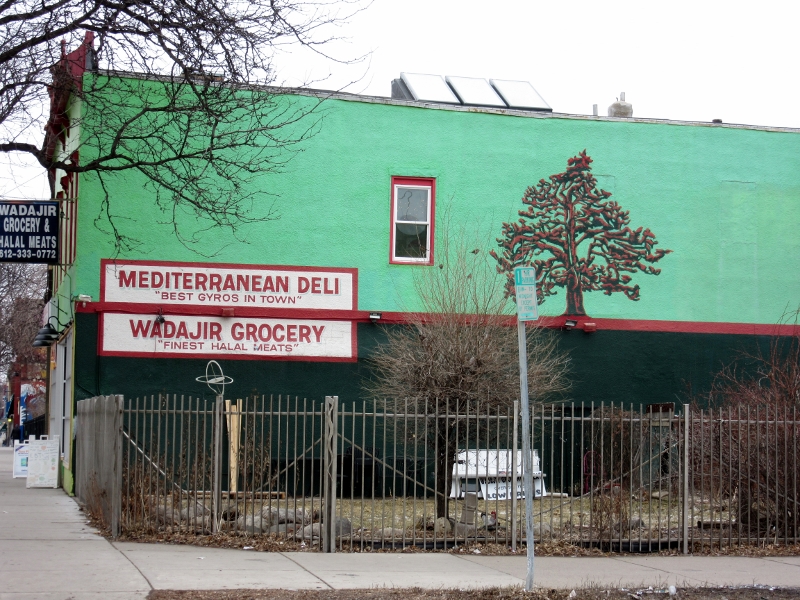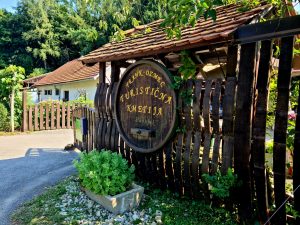Although it’s been more than a month since I was in the States, one morning in particular keeps replaying itself in my head – the morning we went to the West Bank and ended up in Somalia.
When we had driven through the Minneapolis neighbourhood of the West Bank on our way to St Paul, I had a made a mental note to come back and walk around what looked like a very vibrant, ethnic neighbourhood, a splotch of colour on an otherwise rather typical grey steel and glass cityscape. I was particularly taken with the shop names. I wanted to get out a world map and stick a pin in every country mentioned.


Also known as Cedar-Riverside and Little Mogadishu, the West Bank is a vibrant community that was at once foreign and familiar. Its demographics have morphed over time, from predominantly Scandinavian at the close of the nineteenth century to being home to one of the largest Somali communities in the USA today. In the 1960s and 1970s, it was where the hippies hung out. Think perhaps Haight-Ashbury in San Francisco. It was here that the activists fought the developers, where the anti-war protesters made their opinions known, where poets and musicians found their inspiration, where actors tread the boards.

Were I to relocate, I might upset the age balance. It’s a young place with nearly three-quarters of the residents under the age of 35. The community sits in the shadow of the multi-coloured Riverside Plaza – where the TV character Mary Richards lived in later episodes of the Mary Tyler Moore Show. Today, it’s home to thousands of Somalian.



We walked, and talked and took photos. And then we got hungry. Not much was open – not even the Acadia pub, which proudly boasts NO CRAP ON TAP on its window decals. Another doorway asked the world to SAY YES TO PEACE AMONG PEOPLE. It was morning and while appreciative, I was craving eggs not invocations to do my civic duty. Breakfast ain’t breakfast without eggs so we popped into the only open café we could find: a large rectangular room with the basic tables and chairs and a small counter at the end whence reigned the woman of the house. A television was showing some soap too asinine to hold anyone’s attention for very long. The menu was a peculiar mix of African takes on America staples. Our fellow diners were all male, all African, and all speaking something other than English. They all seemed to know each other. Those who came in as we were sitting did the rounds, greeting all the others in the room, moving from table to table if a something more personal than a catchall hello from the doorway was needed.


We sat over coffee so strong a mouse could trot across it. We ate food that again, was both foreign and familiar. And we listened to everything going on around us, unable to understand a word. It was light years away from any TV depiction of the American Mid West. A parallel universe. And I wondered how long it would be before the language was lost, the culture diluted, and the food choice changed. I thought about the melting pot that is America and the generations of immigrants who now call it home. And I thought of Europe and the myriad migrant communities that are mushrooming in , say, Germany and Dublin, whole neighbourhoods where German and English are the foreign languages and schnitzel and coddle the foreign foods.


Just up the street, Neighbourhood America lives on , unabated. Palmer’s Bar is a local institution. Had it not been so early and had it not been our last day in the city, I could have parked myself on a high stool and paid attention to nothing but the world ticking by.

From the outside it looks like a throwback to the speakeasy days. From this inside, these old photos speak of community and spirit. Ranked by Esquire as one of the best bars in America, a recent review tagged it as a refuge of coexistence, the bar beats with diversity. Anarchists, the homeless and academics all dwell there. Bob Dylan no doubt pounded a few beers here in his Minneapolis days and Bonnie Rait has been known to drop in when she’s recording in town. If I ever needed a reason to go back, this might just be it.


Share this:
- Click to share on X (Opens in new window) X
- Click to share on Facebook (Opens in new window) Facebook
- Click to share on Pinterest (Opens in new window) Pinterest
- Click to share on LinkedIn (Opens in new window) LinkedIn
- Click to share on Reddit (Opens in new window) Reddit
- Click to share on WhatsApp (Opens in new window) WhatsApp
- Click to share on Pocket (Opens in new window) Pocket
- Click to share on Telegram (Opens in new window) Telegram
- Click to email a link to a friend (Opens in new window) Email







8 responses
“. . . how long it would be before the language was lost, the culture diluted, and the food choice changed . . .” But will it ever be? See last week-end’s Sunday Times – or maybe USA is somehow different.
What a find, what an inspiring place………. we need these places in our towns and cities, contrast that area with the antiseptic shopping malls that inhabit the majority of our centres. How can we plan for such places, very difficult……you need a cheap area in a city centre, how many of those are left? These are often areas in transition either on the way up or down but increasingly high land costs in city centres mean there is nowhere for these communities to go. City fathers need to try hard to ensure that there are always such areas left somewhere in the centre so that such vibrant communities can survive and flourish.
Ps did you frighten away the people when you were visiting?
Nope – no-one was remotely curious
We missed Little Mogadishu and Palmer’s. We need to return.
Meet you there for a pint 🙂
Where did you eat breakfast?
A little place opposite the Acadia – only place open